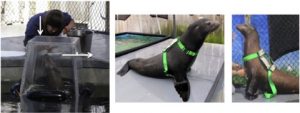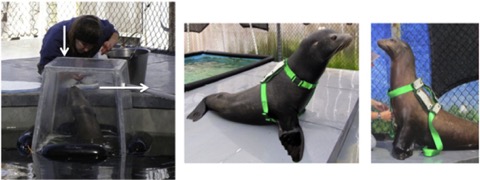Sea Lions in our Changing Ocean
By Amanda Stoltz, SRC Intern
If you’ve ever gazed upon sea lions loafing about in the Californian sun, you might be inclined to think that they are lazy animals. However, as with most marine mammals, sea lions live an active life under the water’s surface. Much of their underwater behavior is unknown to scientists, but a recent study by Neises et al., titled “Examining the metabolic cost of otariid foraging under varying conditions,” explores how sea lions could be affected by warming oceans that cause prey to migrate to deeper waters further offshore.
Sea lions are much better divers than we are, but how long can they spend underwater searching for food before they begin to experience physiological consequences? When marine mammals dive below the surface of the water, the oxygen in their body decreases while the carbon dioxide in their body increases. The authors hypothesized that when a sea lion has to work harder to fish for its prey, the ability of its body to sequester carbon dioxide into bicarbonate diminishes. This hypothesis is difficult to test through observation, so the authors created an enclosure where they could control the amount of prey and test for the energetic cost of diving for prey using a technique called open flow respirometry. The researchers constructed an airtight plexiglass dome with an inflow hole for air and an outflow hole for the sea lion respiratory data to be collected (Fig. 1).

Left: Breathing dome. A nylon hose connected the dome to the TurboFox respirometer for data collection. The white arrow on the top of the respirometry chamber indicates the flow of air into the chamber. The white arrow perpendicular to the top arrow indicates the direction of airflow though the outflow hole leading to the respirometer. Middle: The male sea lion in the drag harness used during cost increased trials. Right: The female sea lion in the drag harnesses used during cost increased trials.
The study was conducted at Moss Landing Marine Laboratories in California using two California sea lions (Zalophus californianus). In order to simulate a high prey encounter rate, the researchers released 36 fish per session, while in a low prey encounter rate the researchers released only six fish. In the experiment, the sea lions controlled the number of dives, dive duration, and surface intervals. Behavior data was collected by multiple real-time cameras installed throughout the enclosure.
The scientists found that while there was no significant difference in oxygen depletion between low and high prey scenarios, the amount of accrued carbon dioxide was significantly higher during low prey scenarios. This proves the researcher’s hypothesis, and reveals that carbon dioxide may be a more sensitive physiological marker than oxygen consumption when examining the metabolic cost of foraging in sea lions.
These findings will help support the conservation of sea lions in our changing seas. In 2015, the stranding rate of sea lions was 10 times the average stranding level, and NOAA listed prey availability as one of the likely causes (NOAA Fisheries, 2015). Closer examination of carbon dioxide as a physiological marker in sea lions will provide scientists with greater insight into the effect of limited prey on these iconic marine mammals.
Works Cited
Neises, V., Zeligs, J., Harris, B., Cornick, L. 2017. Examining the metabolic cost of otariid foraging under varying conditions. J. Exp. Biol. 486: 352-357.
NOAA Fisheries, 2015. 2015 elevated California sea lions strandings in California. http:// www.westcoast.fisheries.noaa.gov/ mediacenter/faq_2015_ca_sea_lion_strandings. pdf




Leave a Reply
Want to join the discussion?Feel free to contribute!